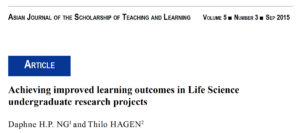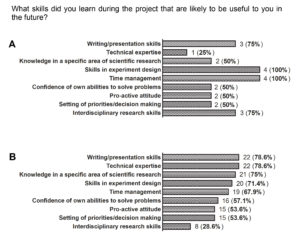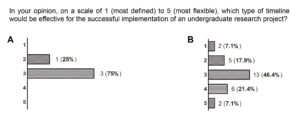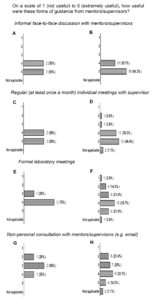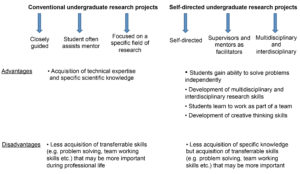Achieving improved learning outcomes in Life Science undergraduate research projects
This reflection is based on an exciting and fun research project on endophytes that we did with four undergrads and various faculty and postgraduate student mentors:
ABSTRACT
Undergraduate research projects are important components in Life Science undergraduate education. They help in the development of important skills, including technical, writing, presentation skills as well as skills in critical analysis. However, a number of important transferrable skills are commonly not well addressed in undergraduate research projects. These include the ability to make decisions and work independently to solve problems, the development of multi-disciplinary and interdisciplinary research skills, the ability to work as part of a team and the development of creative thinking skills. Here we describe the implementation of a self-directed research project for advanced level undergraduate students. This research project involves the isolation and testing of endophytes (symbiotic microorganisms associated with plants) for useful properties. We evaluated whether this project is suitable to address currently un-met learning objectives. Based on observations and student feedback, we found that some important transferrable skills were successfully addressed in the project. We also discuss a number of challenges to the implementation of this approach in advanced level undergraduate research projects. Overall, we conclude that the endophyte-based research project helped the students to develop important transferrable skills that are likely to be advantageous in their future professional life.
INTRODUCTION
We live in the information age, where the challenge is not to find relevant information, but to analyze and evaluate information, to integrate information and to generate new knowledge. The ability to readily access and obtain scientific information has prompted a re-evaluation of teaching goals and approaches in higher education. It is widely agreed that for students to make contributions to our society, the major focus should be on transferrable skills. These include independent and life-long learning, problem solving and creative thinking, the ability to take multidisciplinary and interdisciplinary approaches as well as communication skills. In a recently published survey of employers in Australia on important skills of Science, Technology, Engineering and Mathematics (STEM) graduates, the ability for active learning (learning on the job) was rated nearly twice as high as occupation-specific STEM skills (Prinsley & Baranyai, 2015). Other skills that were rated markedly higher than occupation-specific skills were abilities in critical thinking, complex problem solving and creative problem solving. Even in primary and secondary education, an important career destination for Life Science students, there is increasing emphasis on inquiry-based as well as integrated learning (Wolf & Fraser,2008; Hogan et al, 2013). This requires that graduates have skills and experiences that allow them to engage primary and secondary school students in these activities. Despite these new challenges and changing demand, the teaching practices in undergraduate education have undergone few changes over time.
This also applies to undergraduate research projects, such as the final year project. Laboratory research activities, in particular undergraduate research projects, are important components in life science teaching (Hofstein & Lunetta, 1982; Barak & Dori, 2004; Chang, 2005). However, the current common practice is not well suited to address the existing demands and challenges. In a good scenario of an undergraduate research project, the student is given an objective or hypothesis and provided with guidance to address the project goal. This often involves acquiring of problem solving skills. In this scenario, the student can, but is not required to make intellectual contributions to defining and achieving the goals of the project and devising the specific approaches. In a less favorable scenario, the student assists a graduate student or research assistant and obtains mainly technical skills. However, both of these approaches do not significantly contribute to the development of a number of important and transferrable skills, such as the ability to make decisions, to work independently as well as to work as part of a team, to solve problems creatively and to develop own ideas.
Here we describe the use of a self-directed research project based on plant-associated microorganisms (endophytes) that we conducted over the course of one academic year with undergraduate life science students in their third and fourth year of study. This project has previously been used in high school, first year undergraduate and summer school modules and has been shown to lead to positive learning outcomes (Bascom-Slack et al, 2012). We hypothesized that the approach could be adapted for more advanced undergraduate students to meet important learning objectives and to help the students to develop transferrable skills. The specific skills that we focused on were the ability to make decisions and work independently to solve problems, the development of multi-disciplinary and interdisciplinary research skills, the ability to work as part of a team and the development of creative thinking skills. In this paper, we describe how the project was implemented to meet these objectives and discuss our experiences based on our own observations as well as student feedback.
IMPLEMENTATION OF THE PROJECT
The goal of the project is the isolation and identification of endophytes, i.e. endosymbiotic fungi and bacteria that inhabit healthy plants, and the subsequent development of applications in which the endophytes or endophyte-derived metabolites can be used. In our project, we included two third-year and two fourth-year students with an average academic record. Naturally, it was necessary to find co-supervisors and mentors with complementary expertise in areas such as plant biology and bioinformatics. We also included four postgraduate students as mentors. It was apparent that the motivation level of the postgraduate students was very high as they regarded the project as an opportunity to broaden their background and acquire mentoring skills.
Despite the multi-disciplinary content, the project was relatively easy to implement as endophytes can be isolated from freely available sources. The total cost of implementing this project was estimated to be approximately $10,000, including some required equipment. Literature on the isolation and screening of endophytes is widely available and supervisors and mentors read up to familiarize themselves with the background information. In addition, the isolation of endophytes is technically feasible and does not require much pre-requisite knowledge or sophisticated technical equipment. Protocols for standard steps are also available (Bascom-Slack et al, 2012).
MOTIVATION OF THE UNDERGRADUATE STUDENTS
One aspect that became clear very early on is that the motivation level of the students was extremely high. This likely can be attributed to various factors. The multiple success points during the course of isolation, identification and screening of endophytes provide motivation to sustain students’ interest during the project. Furthermore, the great variety of endophytic microorganisms increases the likelihood of scientific discovery and makes the outcome of the project unpredictable. As previously observed, the unpredictable outcome increases student motivation and provides a sense of intellectual ownership through scientific discovery (Strobel & Daisy, 2003; Strobel & Strobel et al, 2007).
In our project, we focused specifically on non-flowering plants, given that this group of plants did not heavily feature in previous endophyte studies. Each of the undergraduate students focused on different non-flowering plants. It was highly impressive how fast and with what enthusiasm the students learned about their plant group, even though none of the students had a particular interest in botany before the project.
Although there was a rough timetable for conducting the project, the students showed an astonishing degree of self-motivation. As an illustration, during the culturing and isolation of the endophytes, which was performed during the semester break, the students frequently worked until very late hours. One of the students commented that she had never been this excited about something before. As mentioned above, the high degree of self-motivation is likely a consequence of the sense of project ownership that the students felt right from the start. The students were aware that they were the first to try to isolate endophytes from their specific plants and that the outcome was completely unknown. Hence, they were very eager to analyse their results and expressed excitement about each isolated endophyte. It is well known from theories on learning and instruction that the learning of students is enhanced if they are well-motivated (Bosma & Wijffels, 2003). Thus, it is likely that a major reason for the success of the project is the high motivation level of the students.
DEVELOPMENT OF INDEPENDENT PROBLEM SOLVING AND DECISION MAKING SKILLS
The first part of the study consisted of collecting plants and isolating endophytes from different plant parts. For this part of the study, standard protocols have been published and could be utilized by the students (Bascom-Slack et al, 2012). However, there were a number of challenges for the students. Since the techniques and methods were not established in the laboratory, the students had to understand and follow the protocols independently. Furthermore, they had to adapt the protocol to their specific plant and set up controls to increase the likelihood that the isolated microbes are indeed endophytes and not microbes isolated from the outside of the plant (exophytes). The students could discuss their plans with their mentors as well as among themselves, and this likely further deepened the learning process. Because the students realized that the likelihood of successful isolation of endophytes is dependent on the quality of their work, they took extraordinary care and initiative to implement modifications to the protocol, or even went back and recollected new plants in order to repeat the endophyte isolation. This degree of initiative, pro-activity and independence is very unusual for undergraduate students at such an early stage of their project, at which other students would usually be following instructions from their supervisor or mentor. The self-initiated, self-directed and experiential learning by the students is likely to be a more lasting and pervasive form of knowledge acquisition (Combs, 1982).
Another important aspect of the project was that the students had the opportunity to experience what it is like to be an independent researcher. They had to make many decisions on their own, from deciding on a nomenclature for their isolated endophytes to deciding which methods to use in preparing extracts and testing for biological activities. They also had the opportunity to engage in non-research-related work that is essential to the successful implementation of every research project, such as the sourcing of laboratory equipment. (The students were in charge of sourcing and buying necessary instruments, such as microscope, shaker and rotary evaporator, based on a limited budget.) This provided another aspect to their experience as independent researchers.
As the approach in this project differed from most other commonly conducted Life Science undergraduate research projects in the university, feedback was collected from the students six months after the completion of the project in a survey. In this survey, the students provided feedback on a number of desired learning outcomes. The same survey was also completed by 28 Life Science undergraduates who conducted other third-year and final-year projects in the same department. The nature of the projects undertaken by these students is likely to vary widely given the different approaches of supervisors to design, plan and conduct of undergraduate research projects. The responses from the two groups of undergraduates were then analysed and compared.
Given that decision making and proactive attitudes were important learning outcomes and are attributes that are of great importance for the future career of the students, the students were asked about their role in determining the research direction. The students involved in the endophyte project indicated that they were highly involved (Options 4 and 5) in deciding the research direction of the project (Fig. 1A). In contrast, only 32% of the other undergraduates surveyed perceived that they were highly involved in directing their research with 43% of the other undergraduate respondents indicating an intermediate level of involvement in deciding the direction of their project (Fig. 1B). The wide spread of the survey results in the general Life Science student group also confirms that the approach of supervisors to conduct undergraduate research projects varies widely.
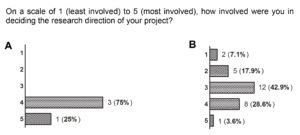
Figure 1. Undergraduate student responses when asked about their involvement in deciding the research direction of their project. (A) Students who completed the endophyte research project. (B) Other students.
When asked about the skills that the students acquired during their undergraduate research project, all endophyte project students indicated that they had acquired skills in experimental design and in time management. In contrast, only approximately 70% of the other undergraduates agreed that they have acquired skills in experimental design and in time management. Among the undergraduate student group carrying out more conventional projects, the acquired skills with the highest scores were writing and presentation skills, technical expertise and knowledge in a specific area of scientific research. While the endophyte project students indicated similarly high scores for writing and presentation skills, their scores for technical expertise and specific scientific knowledge were lower. This is likely due to the nature of the endophyte project, which has a more broad and diverse focus with less depth compared to a more traditional research project that focuses on one specific subject. Moreover, surprisingly, the more independent and interdisciplinary character of the endophyte project did not result in improved perceived outcomes in terms of non-technical skills, such as proactive attitude, confidence in own abilities to solve problems and setting of priorities (Fig. 2A). The reasons for this are currently not clear, but it would be useful to assess these skills more objectively.
Figure 2. Undergraduate student responses when asked to indicate the skills learnt during the project that were likely to be useful to them in the future. (A) Students who completed the endophyte research project. (B) Other students.
One challenge of undergraduate research projects in general as compared to laboratory practicals is the lack of a structured framework. Undergraduate laboratory practicals usually have clear objectives and intermediate checkpoints and are often intensely guided. Therefore, given that the students were likely not used to the required self-direction in their project, we included in the survey a question about the preferred level of structure. Specifically, the students were asked whether they preferred a more defined or more flexible timeline in the project. Interestingly, most of the undergraduate students indicated preference for an intermediate level of structure (Fig. 3). This may be because the students had to complete other modules during the research project and timelines may have helped them to plan and set priorities.
Figure 3. Undergraduate student responses when asked for their opinion about the kind of timeline that would be effective for successful implementation of an undergraduate research project. (A) Students who completed the endophyte research project. (B) Other students.
When asked about the effectiveness of different forms of guidance from the mentors or supervisors, informal face-to-face discussion with mentors and supervisors as well as regular individual meetings with supervisors were perceived by both groups of students as the most effective forms of guidance (Fig. 4A and 4B). Formal laboratory meetings were the next most effective form of guidance. There were mixed responses to non-personal consultation, such as via email, from both groups of students with approximately 50% of all respondents indicating an intermediate level of effectiveness (Options 2 and 3) (Fig. 4G and 4H). These results show that personal interaction with students is the most effective form of guidance. In addition to regular individual meetings and discussions, it was found that regular meetings with students presenting their research progress to the mentors and supervisors were effective in ensuring that the research was on track.
Figure 4. Undergraduate student responses when asked to evaluate the effectiveness of various forms of guidance from mentors and supervisors. (A, C, E, G) Responses of students who completed the endophyte research project on the various forms of interaction with mentors and supervisors. (B, D, F, H) Responses of other students on the various forms of interaction with mentors and supervisors.
In conclusion, based on our experience and the feedback provided by the students, the self-directed endophyte research project has succeeded in developing skills important in independent problem solving. Although students of the endophyte project may have gained less in terms of specialized technical knowledge and specific scientific knowledge, they are likely to have acquired a better insight into the scientific discovery process and obtained more transferrable skills that may be important during their professional life.
DEVELOPMENT OF MULTI- AND INTERDISCIPLINARY RESEARCH SKILLS
There is wide agreement that solutions to major problems in today’s world are more likely to come from multi-disciplinary and interdisciplinary approaches. In fact, many real life problems are highly complex and require collaboration from experts from different disciplines. In multi-disciplinary approaches, it is necessary that experts from different disciplines work together to solve a problem. Interdisciplinary approaches go beyond that; the experts work together to create something new that crosses the barrier of disciplines. Interdisciplinary work requires that the involved individuals are able to communicate well with experts from different areas or that they have a basic understanding of other disciplines. Therefore, in addition to specialized skills, Life Science students should ideally obtain during their undergraduate education an understanding of the concept of multi- and interdisciplinary approaches, a basic understanding of other areas and disciplines as well as excellent communication skills.
Naturally, the best way to acquire such skills is for undergraduate students to engage in projects that involve multiple disciplines or sub-disciplines. With the endophyte project, it was possible to address this learning objective to some degree. Thus, the students engaged in various areas, including botany, bioinformatics, microbiology and biochemistry. The students also had opportunities to develop communication skills as they had to discuss their work throughout the project with experts from different areas and to present their work at the end of the project to examiners who were not familiar with all areas of the work. By working with other scientists from various disciplines, the students gained a better appreciation of the interdisciplinary nature of scientific research.
DEVELOPMENT OF TEAMWORK SKILLS
To be successful in scientific research, it is essential to interact with other scientists, to exchange knowledge, ideas and experiences and to discuss scientific results. It can be argued that in professional areas other than scientific research, it is equally important to communicate with people with similar and other backgrounds. Undergraduate students conducting research projects often have limited opportunities to develop these skills. In this respect, the endophyte project is unique in two regards. Firstly, the four students worked in parallel on related projects. Thus, all students isolated endophytes from different plant species and carried out the first part of the project using the same general techniques and methods. This allowed for a great amount of interaction to share experiences, explain techniques and discuss results. This also introduced the aspect of peer mentoring, which helped the students to further deepen their knowledge and understanding of the used techniques and methods. Instruction-based activities such as mutual teaching are well acknowledged as effective learning methods (Stenfors-Hayes et al, 2010, Saitta et al, 2013).
Secondly, throughout the project, the students interacted with multiple supervisors and mentors, each with different expertise. This setting differs from a more conventional project in which the student usually has only one mentor or supervisor who is an expert in the specific area involved in the student’s research. In contrast, in the endophyte research project, the students were challenged to integrate information from different mentors and supervisors and mediate between the different areas of expertise.
Lastly, in addition to these aspects, the project also required teamwork in practical terms. Thus, the students had to prepare reagents and materials to be used by all involved undergraduates and coordinate their work and timetables. The project thus imparted very practical teamwork skills onto the students.
DEVELOPMENT OF CREATIVE THINKING SKILLS
One of the greatest and often neglected challenges in undergraduate education is the development of creative thinking skills. Creation of new ideas requires students to analyze, synthesize and evaluate information, and as a result of this process, develop a new idea or way to solve a problem (Anderson et al, 2001). Hence, it is important to give students opportunities to develop essential skills to acquire these abilities to ultimately be able to create and innovate. The many potential applications of endophytes and endophyte-derived metabolites can provide a wide scope for students to design their own specific research questions (Strobel & Daisy et al, 2003).
In order to realize this potential, each student was asked at the beginning of the project to develop their own idea for a potential application of endophytes or endophyte-derived metabolites. It was emphasized that the major criterion for developing any research question was to address an important problem. Developing their research question required that the students read relevant scientific publications as well as material from other sources, and analyze and evaluate information. In the first laboratory meeting, the students then presented an idea for a property of the endophytes that they were interested in and explained why that specific research question was important. Potential applications proposed by the students included the testing of endophyte-derived extracts for anti-oxidative, anti-apoptotic and anti-inflammatory properties. After the students presented their research idea, potential strategies to address the research question were discussed with both the students and mentors in a group. This discussion was very important as it allowed the students to participate in the evaluation of different approaches and methods, which normally is carried out by the supervisor and mentor. After the meeting, the students thus had a direction on how to develop an approach to address the specific research question.
During the later stages of the project, the students then tried to develop specific assays to test endophytic extracts for the desired properties. Two of the students chose to try to develop novel approaches that ultimately did not succeed. Nevertheless, the experience of trying to set up and optimize a new method was likely very useful and demonstrated that the creative process often involves the revising or even discarding of ideas and the development of new approaches. However, even when trying to set up assays that have been published in the literature, the students had to troubleshoot and optimize, as these assays were not established in the laboratory. This is an aspect that is different from more conventional undergraduate research projects that mainly involve learning of protocols that are already established in the respective laboratories.
SHORTCOMINGS AND CHALLENGES
Compared to the students conducting more conventional undergraduate research projects, the students involved in the endophyte project indicated that they had acquired less technical expertise and possibly less knowledge in a specific research area with only 25% and 50% of them choosing these options, respectively. This is in contrast to the other surveyed undergraduate group of whom approximately 75% indicated that they had acquired technical expertise and knowledge in a specific area of scientific research (Fig. 2). The reason for this is likely the more multi-disciplinary approach of the endophyte research project. However, the survey results raise the question of whether specific detailed knowledge and skills are important learning outcomes in undergraduate research projects. It would appear that in their eventual place of employment, the Life Science graduates are unlikely to be able to directly apply the expertise they have gained in their research project. Rather, it is more likely that the graduates will have to learn new skills and expand existing knowledge or even acquire completely new knowledge. Hence, it would seem more important that students possess the skills to develop new methods and acquire new expertise (Nicolescu & Paun, 2009). Therefore, there currently is likely a discrepancy between the major learning outcomes of common undergraduate research projects and the demands on students upon graduation.
Another important issue relates to the evaluation, in which the examiners may consciously or unconsciously equate success with good research results. However, undergraduate research projects aimed at developing independent problem solving and creative thinking skills involve students taking risks and pursuing ideas that may not work out. There is some concern that the current evaluation system discourages this approach, although attempts have been made to emphasize critical analysis, problem solving and presentation skills in the assessment of third and final year Life Science undergraduate research projects.
It should also be mentioned that it is important to emphasize that the undergraduate student survey performed in this study reflects only student perceptions. It would be important to more objectively compare the actual learning outcomes of each of the two student groups. This may also resolve whether the absence of any difference in acquiring a more proactive attitude, confidence in own abilities to solve problems and setting of priorities between the student groups is real or only based on student perceptions (Fig. 2A).
Finally, it was necessary to find co-supervisors and mentors with complementary expertise in areas such as plant biology and bioinformatics. It is likely that experts in all required areas exist in most Universities. However, a lack of incentives or interest of co-supervisors could be a potential problem as the project is in most cases not directly related to the research interests of any supervisors. Hence, additional incentives to encourage supervising of self-directed multi-disciplinary research projects would be helpful to promote these types of undergraduate research projects.
Figure 5. Comparison of conventional undergraduate research projects and self-directed undergraduate research projects.
CONCLUSION
Self-directed projects are useful for training undergraduate Life Science students to meet the challenges of the information age and multi-disciplinary research. Unlike students who engaged in conventional undergraduate research projects, students who completed the endophyte project experienced what it was like to be an independent researcher as well as developed multi- and interdisciplinary research skills (Fig. 5). We believe that these and other skills such as independent problem solving and creative thinking will be beneficial for the students in their future careers. Hence, the inclusion of self-directed projects (as described in this paper) in the undergraduate Life Science syllabus is highly recommended.
ACKNOWLEDGEMENTS
The authors would like to thank the undergraduate students, Tan Shi Hua, Lim Shuying, Lim Ee Chien and Seah Wen Hui, and post-graduate student mentors Daphne Wong Pei Wen, Christine Hu Zhi Wen and Ng Mei Ying involved in this project. We would also like to thank Prof. Benito Tan and Dr. Ho Boon Chuan for their expertise and guidance as well as Dr Junichi Matsuo, Song Zhi Jian and Akshamal Gamage for their generous help during parts of the project.
REFERENCES
Anderson, L.W. Krathwohl, D.R. & Bloom, B.S. (eds)(2001). A taxonomy for learning, teaching, and assessing: A revision of Bloom’s taxonomy of educational objectives. New York: Allyn & Bacon.
Bascom-Slack, C.A., Arnold, A.E. & Strobel, S.A. (2012). Student-directed discovery of the plant microbiome and its products. Science, 338, 485–486.
Barak, M, & Dori, Y.J. (2004). Enhancing undergraduate students’ chemistry understanding through project-based learning in an IT environment. Science Education, 89(1), 117-139.
Bosma, R. & Wijffels R.H. (2003). Marine biotechnology in education: a competitive approach. Biomolecular Engineering, 20, 125-131.
Chang, H. (2005). Turning an undergraduate class into a professional research community. Teaching in Higher Education , 10(3): 387-394.
Combs, A.W. (1982). Affective education or none at all. Educational Leadership, 39(7), 494-497.
Hofstein A. & Lunetta V.N. (1982). The role of the laboratory in science teaching: neglected aspects of research. Review of Educational Research Summer, 52(2), 201-217.
Hogan, D., Kwek D., Towndrow, P., Abdul Rahim R., Tan T.K., Yang, H.J. & Chan M. (2013). Visible Learning and the Enacted Curriculum in Singapore. In: Deng Z.,
Gopinathan S. & Lee C. K. E. (eds.). Globalization and the Singapore Curriculum: From Policy to Classroom. Singapore: Springer-Verlag.
Nicolescu, L. & Paun C. (2009). Relating Higher Education with the Labour Market: Graduates’ expectations and employers’ requirements. Tertiary Education and Management, 15(1), 17-33.
Prinsley R and Baranyai K. (2015). STEM skills in the workforce: What do employers want? Australian Government Office of the Chief Scientist: Occasional Paper Series Issue, 9, 1-4.
Saitta, E. K., Legron-Rodriguez T., Bowdon M. A. (2013). An inquiry into the water around us. Science, 341, 971 972.
Stenfors-Hayes, T., Kalen, S., Hult, H., Dahlgren, L. O., Hindbeck H, Ponzer S. (2010). Being a mentor for undergraduate medical students enhances personal and professional development. Medical Teacher, 32, 148–153.
Strobel, G. & Daisy, B. (2003). Bioprospecting for microbial endophytes and their natural products. Microbiology and Molecular Biology Reviews, 67(4), 491-502.
Strobel, S.A. & Strobel, G.A. (2007). Plant endophytes as a platform for discovery-based undergraduate science education. Nature Chemical Biology, 3(7), 356-359.
Wolf, S.J. & Fraser, B.J. (2008). Learning environment, attitudes and achievement among middle-school science students using inquiry-based laboratory activities. Research in Science Education, 38(3), 321-341.
